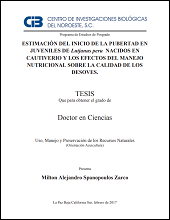Mostrar el registro sencillo del ítem
Estimación del inicio de la pubertad en juveniles de Lutjanus peru nacidos en cautiverio y los efectos del manejo nutricional sobre la calidad de los desoves
| dc.contributor | MINERVA CONCEPCION MALDONADO GARCIA | |
| dc.contributor | FELIPE DE JESUS ASCENCIO VALLE | |
| dc.creator | MILTON ALEJANDRO SPANOPOULOS ZARCO | |
| dc.date | 2017-02-24 | |
| dc.identifier | http://cibnor.repositorioinstitucional.mx/jspui/handle/1001/423 | |
| dc.identifier.uri | http://dspace.cibnor.mx:8080/handle/123456789/2306 | |
| dc.description | El éxito del proceso reproductivo de peces marinos, está determinado principalmente por la manipulación de los organismos, su condición nutricional, así como las condiciones ambientales y las técnicas de inducción al desove. El huachinango del Pacífico, Lutjanus peru, es una especie atractiva para la acuicultura. Sin embargo, su reproducción en cautiverio no había sido factible, debido a la falta de conocimiento sobre los requerimientos alimenticios, las condiciones de manejo y el proceso reproductivo. En el Centro de Investigaciones Biológicas del Noroeste (CIBNOR), tras seis años de mantenimiento de reproductores silvestres de L. peru, se lograron los primeros desoves en cautiverio de manera natural con sincronización de la puesta entre hembras y machos, es decir, sin la aplicación de hormonas y bajo las condiciones ambientales de temperatura y fotoperiodo existentes en el lugar (24°08'N, 110°25'W). Esta primer generación (F1) abrió la posibilidad de evaluar con precisión por primera vez la edad de primera madurez de la especie; así como los efectos que produce durante la reproducción la implementación de distintas dietas, ya que son peces que se adaptan con facilidad a dietas fabricadas. La primera madurez se presentó a los 4 años de edad, con un peso promedio de 2,829 ± 80.9 g y talla promedio de 540.3 ± 4.6 mm. Los primeros desoves sucedieron en el mes de junio del 2013, con la sincronización reproductiva entre los machos y las hembras en cautiverio, esto coincidió cuando el fotoperiodo fue de 13 horas luz y 11 de obscuridad, a un aumento de temperatura del agua del tanque de 24.81 ± 1.4 °C, y finalizando los desoves el mes de diciembre, con un decremento de temperatura a 21.2 ± 1.5 °C y a 10 horas luz y 14 horas de obscuridad. Previo a la madurez sexual, se evaluaron los niveles hormonales (estradiol, testosterona y 11-keto-testosterona) encontrando un aumento en las concentraciones antes del inicio de la temporada reproductiva [...] | |
| dc.description | The success of the reproductive process of marine fish is mainly determined by manipulations of the organisms, their nutritional status, as well as environmental conditions and techniques of spawning induction. The Pacific red snapper, Lutjanus peru, is an attractive species for aquaculture. However, their reproduction in captivity has been not feasible, due to lack of knowledge about nutritional requirements, management conditions and reproductive process. At Centro de Investigaciones Biológicas del Noroeste (CIBNOR), the first natural spawning events were achieved without hormonal applications and under local conditions of temperature and photoperiod (24°08'N, 110°25'W) after six years of maintenance of wild brood stock of L. peru, This first generation (F1) opened the opportunity to assess the first maturation age in this species and the effects of different diets on their reproduction, because the Pacific red snapper is a fish with easy adaptation to artificial diets. The first maturation was at four years old with an average weight of 2,829 ± 80.9 g and size of 540.3 ± 4.6 mm of total length. The first spawning event were observed in June 2013, with synchronization of female and male in captivity conditions; when the daylength was 13 hours and temperature of 24.81 ± 1.4 °C, while December was the last month of spawning, when the photoperiod and the temperature decreased (daylength of 10 hrs. and 21.2 ± 1.5 °C of temperature). Hormonal levels (estradiol, testosterone and 11-ketotestosterone) were measured prior to sexual maturity, recording an increment in the concentrations of these hormones next before the beginning of the spawning season. Implementation of a diet supplemented with microalgae (Gramatophora sp.) to the Pacific red snapper boodstock, increase significantly the hatching rate (P<0.05), but without significant variations of this parameter during whole spawning season, while the fishes fed with the control diet (without microalgae) had significant lower hatching rates (P<0.05). Significant differences in eggs diameter was observed, being higher in fishes fed with the experimental diet (supplemented with microalgae) and without significant variations throughout the spawning season. According the obtained results we can conclude that improvements in the reproductive process are possible, increasing the egg diameter and the hatching rates by the management of diets. | |
| dc.format | application/pdf | |
| dc.language | spa | |
| dc.publisher | Centro de Investigaciones Biológicas del Noroeste, S.C. | |
| dc.rights | info:eu-repo/semantics/openAccess | |
| dc.rights | http://creativecommons.org/licenses/by-nc-nd/4.0 | |
| dc.subject | info:eu-repo/classification/AUTOR/Primera madurez; desempeño reproductivo; calidad de huevos; Lutjanus peru | |
| dc.subject | info:eu-repo/classification/cti/2 | |
| dc.subject | info:eu-repo/classification/cti/24 | |
| dc.subject | info:eu-repo/classification/cti/2401 | |
| dc.subject | info:eu-repo/classification/cti/240105 | |
| dc.subject | info:eu-repo/classification/cti/240105 | |
| dc.title | Estimación del inicio de la pubertad en juveniles de Lutjanus peru nacidos en cautiverio y los efectos del manejo nutricional sobre la calidad de los desoves | |
| dc.type | info:eu-repo/semantics/doctoralThesis |


